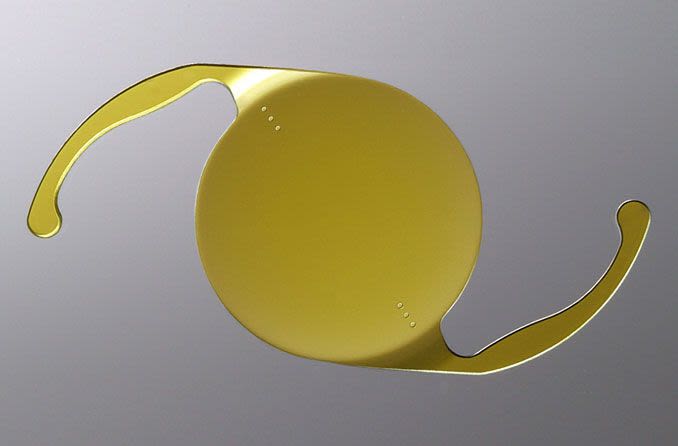Astigmatism and cataract? A toric IOL can fix both

Most people with cataracts want not only to have clear vision after cataract surgery, but freedom from eyeglasses as well.
One thing that can prevent that from happening is residual astigmatism after surgery. Astigmatism is where our corneas are more curved in one direction that they are in another. This means that the cornea is rugby ball shaped and can focus in different places depending on the curve of the cornea.
Astigmatism is very common before and after cataract surgery. Almost one in three people who are candidates for cataract surgery have at least 1.0 diopter (D) of astigmatism, which is enough to cause noticeably blurred vision without eyeglasses or contact lenses.
In the past, intraocular lenses (IOLs) used in cataract surgery could not correct astigmatism. Some astigmatism could be corrected if the cataract surgeon chose to make incisions in the cornea during cataract surgery — a procedure called limbal relaxing incisions. Unfortunately, this procedure can correct only limited amounts of astigmatism, and sometimes outcomes are unpredictable.
Thankfully, special intraocular lenses called toric IOLs have been developed to more predictably correct astigmatism during cataract surgery.
How toric IOLs work
Like toric soft contact lenses for astigmatism, toric IOLs have different powers in different meridians of the lens to correct the asymmetric power of the eye that is characteristic of astigmatism. The toric IOL has the corresponding rugby ball shape to the cornea so the two will cancel each other out resluting in an eye that can foucs without glasses for astigmatism
Cataract surgery with a toric lens implant is essentially the same as cataract surgery with a conventional IOL, but with a couple of important differences.
Prior to surgery, measurements are taken to enable cataract surgeons to choose the most beneficial toric IOL power and the required orientation of the implant in the eye to correct the astigmatism successfully. The long axis of the rugby ball in the toric implant has to align precisely witht he corresponding long axis in the cornea.
Toric IOLs have special markers on the lens that enable the surgeon to see the orientation of the astigmatism correction in the lens. Once the toric IOL is implanted in the eye, the surgeon then rotates the lens so the astigmatism correction is properly aligned for best results.
Use of a toric IOL during cataract surgery does not increase the risk of common cataract surgery complications, but a misaligned toric IOL can cause blurred vision that cannot easily be corrected with eyeglasses or contact lenses.
Toric IOL outcomes
Research has shown that toric lenses produce excellent visual results after cataract surgery and can correct astigmatism more effectively than limbal relaxing incisions.
A study of visual outcomes of cataract surgery with one popular brand of toric IOL found that 92.6% of eyes with at least 0.75 D of astigmatism prior to surgery had uncorrected visual acuity of 20/40 or better after surgery. Also, the mean patient satisfaction score after surgery was 9.7, using a scale from 0 (not at all satisfied) to 10 (very satisfied).
Cost of toric IOLs
Toric IOLs are more costly than conventional IOLs used in cataract surgery. Also, properly implanting a toric IOL is more challenging for cataract surgeons than using a conventional IOL that's not designed for astigmatism correction surgery.
For these reasons, cataract surgery with astigmatism-correcting toric IOLs typically costs more than cataract surgery with conventional IOLs. Ask your eye care professional for cost information in your area. Toric Implants are occasionally used in the NHS but it is not common. Most insurance companies will not pay fro the extra costs of this implant so it will have to be paid for separately if you are having private surgery.
Consider all options
During your consultation prior to cataract surgery, your surgeon will discuss with you the best astigmatism-correcting options for your particular needs so you can be less dependent on eyeglasses after your cataracts are removed.
FIND AN OPTICIAN: if you're concerned about your vision, visit an optician near you.
Page published on Monday, 14 March 2022






